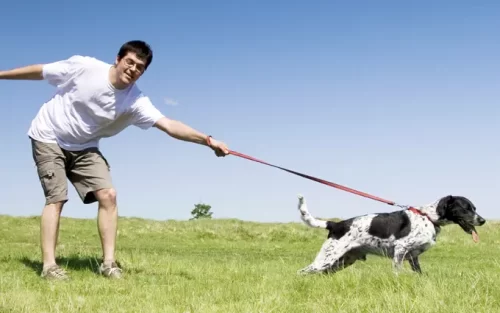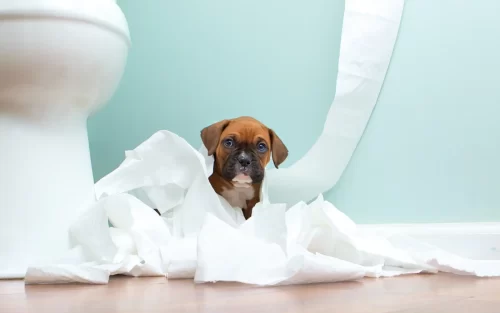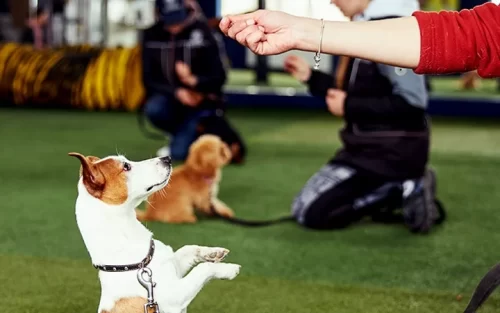Crate training your dog may seem daunting, but it’s an essential skill for you and your furry friend. When done correctly, the process can provide a safe and comfortable space for your dog and help with housebreaking, travel, and preventing destructive behavior.
The idea of crate training is to create a positive association between the crate and your dog’s experiences, making it their very own sanctuary. It’s important to remember that a crate should never be used as a punishment, but rather as a secure place where your pet can feel at ease. This way, your dog will naturally gravitate toward their crate when they want to rest or feel overwhelmed.
Introducing your dog to crate training might initially seem challenging, but with patience, consistency, and a step-by-step approach, your dog will soon learn to love their cozy den. While some dogs may take to it quickly, others might require more time and effort. The key is to stay persistent and maintain a positive attitude throughout the process.
This comprehensive guide will provide you with all the information you need to crate train your dog successfully. We’ll cover the benefits of crate training, selecting the right crate, crate training techniques, and tips for creating a comfortable environment for your pet. Additionally, we’ll address common challenges and solutions, ensuring you’re well-equipped to tackle any obstacles that might come your way.
So, let’s dive in and explore the world of crate training, helping you and your dog embark on a journey towards a happier, more harmonious life together.
Why Crate Train Your Dog?
Provides a Safe Space
Crate training creates a secure den-like environment that mimics a dog’s natural instincts to seek shelter. It gives them a space they can call their own, where they feel safe and protected.
Prevents Destructive Behavior
Crates help prevent destructive behavior by providing your dog with a confined area when you’re not home or unable to supervise them. This reduces the risk of damage to your belongings and keeps your dog safe from ingesting harmful objects.
Aids in Potty Training
Using a crate is an effective way to housebreak your dog. Dogs instinctively avoid soiling their sleeping areas, so crate training helps teach them to hold their bladder until they can go outside.
Eases Travel and Vet Visits
A crate-trained dog is more comfortable during car rides, vet visits, and stays at boarding facilities. This reduces stress for both you and your dog during these potentially challenging situations.
When Not to Crate Train Your Dog
Separation Anxiety
Dogs with severe separation anxiety may become more distressed when confined to a crate. In these cases, alternative solutions, such as working with a professional dog trainer or behaviorist, should be considered.
Prolonged Confinement
Crates should not be used to confine your dog for extended periods. Dogs need regular exercise, socialization, and interaction with their humans. Overusing the crate can lead to boredom, depression, and anxiety.
Choosing the Right Crate
Size
Select a crate that is large enough for your dog to stand up, turn around, and lie down comfortably. However, avoid choosing a crate that is too large, as this can encourage your dog to eliminate in one corner and sleep in another.
Type
Several crate types are available, including wire, plastic, and fabric crates. Choose one that best suits your needs and your dog’s temperament. Wire crates are popular for their durability and visibility, while plastic crates are lighter and more enclosed. Fabric crates are suitable for well-behaved, crate-trained dogs but may not be ideal for puppies or dogs prone to chewing.
Preparing the Crate
Location
Place the crate in a quiet, low-traffic area of your home where your dog can still see and hear their family. This will help your dog feel secure and connected while in their crate.
Comfort
Add soft bedding, blankets, or towels to the crate to make it comfortable for your dog. You can also include an item of your clothing that has your scent to provide comfort and reassurance.
Accessibility
Ensure the crate door is open and secured so that it doesn’t accidentally close and scare your dog while they’re exploring it.
Step-by-Step Crate Training
Introduction to the Crate
Encourage your dog to explore the crate by placing treats or toys inside. Allow them to freely enter and exit the crate without closing the door to build a positive association with the space.
Feeding in the Crate
Begin feeding your dog their meals inside the crate. This will create a positive association with the crate and reinforce it as a safe and enjoyable place.
Gradually move the food bowl to the back of the crate, so your dog must step inside to eat. Close the crate door while they eat and open it immediately after they finish. Increase the time the door stays closed after each meal, eventually allowing your dog to spend more time in the crate after eating.
Building Crate Duration
Once your dog is comfortable eating in the crate, increase the time they spend inside it. Use a command, such as “crate” or “bed,” and encourage your dog to enter the crate with a treat or toy. Close the door and sit nearby for a few minutes. Gradually increase the time you spend away from the crate and the overall duration your dog stays inside.
Overnight Crate Training
Begin crate training overnight by having your dog sleep in the crate. Ensure the crate is in your bedroom or nearby so your dog feels reassured by your presence. If your dog whines or cries during the night, reassure them calmly without letting them out of the crate unless you believe they need to go outside to eliminate.
Leaving Your Dog Home Alone
When you’re ready to leave your dog alone in the crate, start with short absences and gradually increase the duration. Provide a treat or a toy stuffed with treats to create a positive experience. Always ensure your dog has had ample exercise and an opportunity to eliminate before crating them while you’re away.
Troubleshooting Crate Training Issues
Whining and Crying
If your dog whines or cries in the crate, assess whether they need to go outside or if they’re seeking attention. If it’s the latter, avoid reinforcing this behavior by only letting them out when they’re quiet.
Separation Anxiety
If crate training exacerbates your dog’s separation anxiety, seek advice from a professional dog trainer or behaviorist to develop a customized training plan.
Crate Soiling
If your dog consistently soils their crate, consult your veterinarian to rule out any medical issues. Ensure the crate isn’t too large, and adjust your dog’s feeding and elimination schedule to minimize accidents.
Conclusion
Crate training is a valuable skill that can significantly benefit both you and your dog. When done correctly, it creates a safe and comfortable environment for your furry friend, making their crate a haven they’ll happily retreat to. With patience, consistency, and a positive attitude, you’ll soon see your efforts pay off as your dog learns to love their cozy den.
Throughout this comprehensive guide, we’ve covered the benefits of crate training, selecting the right crate, techniques for successful training, and tips for creating a comfortable space for your dog. We’ve also addressed common challenges and provided solutions to help you overcome any obstacles along the way.
Remember, each dog is unique, and the crate training process may vary depending on your dog’s personality, breed, and individual needs. It’s essential to be patient and consistent, adjusting your approach as needed to ensure your dog has the best possible experience.
As you embark on this journey, remember that crate training is just one aspect of responsible pet ownership. Investing time and effort into understanding your dog’s needs and providing a loving, supportive environment builds a solid foundation for a happy, healthy, and well-adjusted canine companion. So, here’s to many more years of joy and companionship with your four-legged friend!



